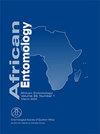Prospects for the Biological Control of Northern Temperate Weeds in South Africa
IF 1.2
4区 农林科学
Q3 ENTOMOLOGY
引用次数: 5
Abstract
The Northern Temperate Weeds programme is a novel biological control (biocontrol) programme started in 2017, with the aim of reducing the impacts of northern temperate weeds that are common, widespread and problematic in the high elevation grasslands of South Africa. As these regions are the most important systems for water security, providing nearly 50% of all water run-off, it is surprising that these species were not targeted for biocontrol previously. Thus far, research has focused on biocontrol feasibility as well as ecological and socio-economic impact studies on several northern temperate weeds, including Pyracantha angustifolia (Franch.) C.K.Schneid, Rosa rubiginosa L., Cotoneaster spp., Rubus spp., (all Rosaceae) and Salix spp. (Salicaceae). In addition, research conducted in the USA and Europe on the natural enemies associated with two of these species, Robinia pseudoacacia L. and Gleditsia triacanthos L. (both Fabaceae and native to the USA), have provided South African researchers with the necessary foundation to initiate programmes against these weeds. Research in South Africa is currently focused on pre-release studies on R. pseudoacacia, using the leaf miner Odontota dorsalis Thunberg (Coleoptera: Chrysomelidae) and the black locust midge Obolodiplosis robiniae Haldeman (Diptera: Cecidomyiidae), and on G. triacanthos, using a seed bruchid, Amblycerus robiniae F. (Coleoptera: Chrysomelidae). Progress with these programmes and potential constraints that may limit success, are discussed.南非北温带杂草生物防治展望
北温带杂草计划是一项新的生物控制(生物控制)计划,始于2017年,旨在减少南非高海拔草原上常见、广泛且有问题的北温带杂草的影响。由于这些地区是水安全最重要的系统,提供了近50%的径流,因此令人惊讶的是,这些物种以前没有成为生物控制的目标。到目前为止,研究的重点是对几种北温带杂草的生物防治可行性以及生态和社会经济影响研究,包括火棘(Pyracantha angustifolia)C.K.Schneid、玫瑰(Rosa rubiginosa L.)、紫檀(Cotonaster spp.)、悬钩子(Rubus spp.)(所有蔷薇科)和柳(Salicaceae)。此外,在美国和欧洲对其中两个物种Robinia pseudoacia L.和Gleditsia triacanthos L.(均为豆科植物,原产于美国)的天敌进行的研究为南非研究人员启动针对这些杂草的计划提供了必要的基础。目前,南非的研究重点是利用潜叶蛛Odontota dorsalis Thunberg(鞘翅目:金花虫科)和黑蝗虫吸浆虫Obolodiplosis robinae Haldeman(Diptera:Cecidomyiidae),以及利用种子bruchid Amblycerus robinae F。讨论了这些方案的进展情况以及可能限制成功的潜在制约因素。
本文章由计算机程序翻译,如有差异,请以英文原文为准。
求助全文
约1分钟内获得全文
求助全文
来源期刊

African Entomology
生物-昆虫学
CiteScore
2.00
自引率
0.00%
发文量
17
审稿时长
6-12 weeks
期刊介绍:
African Entomology (ISSN 1021-3589 – print / 2224-8854 – online) replaced the old Journal of the Entomological Society of Southern Africa in 1993. A single volume consisting of two issues (March and September) is published annually. The journal is indexed in all major abstracting journals
African Entomology is a peer reviewed scientific journal that publishes original research articles and short communications on all aspects of entomology, with an emphasis on the advancement of entomology on the African continent.
 求助内容:
求助内容: 应助结果提醒方式:
应助结果提醒方式:


